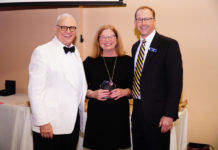Jesuit’s history is present, even 67 years later.
I stood resolute. Glaring at the menu board at the Wendy’s on Greenville. I tried deciding between the triple or double baconator. An amicable comment about my shirt roused me from my beef-induced reverie. “That’s quite a billboard you’ve got on that shirt,” an older, slightly bent but kindly gentleman remarked.
“Thanks… I got it at homecoming last year” I responded, not entirely sure how to do so. The seemingly coincidental conversation turned eerie when he not only recognized the name Jesuit College Prep, but also revealed he was an alumni.
When I asked what graduating class he belonged to, he nonchalantly replied: “the first one”, the Class of 1943 to be exact, only a year after the school opened in 1942. After telling him what grade I was in and what colleges I was looking at, my mother and I sat down to eat a hurried lunch, a lunch that neither of us had expected to be so memorable. The only way I could respond to meeting an original graduate were the pride filled words: “we’re everywhere.”
At Jesuit we pay quite a bit of homage to traditions and to our roots. Legacies, double legacies, even triple legacies fill the halls of Jesuit, and family roots run parallel to Jesuits. After meeting this man, whose name I didn’t even know, I realized how vast the Jesuit community is and – just like the Wendy’s Baconator – I was starving for more.
That graduating class experienced far different things than our own. Advertisements for War bonds lined the tops of their The Roundup newspaper and the Radio club was organized for the sole purpose of “equipping seniors and all those who have reached their 18th birthday… to obtain knowledge of the mysteries of the radio,” knowledge that would serve them in the growing conflict of World War II.
68 years ago students receiving high marks landed on the honor line, not the honor roll, and if you thought the high pitched whine emanating from room 203 was bad, consider not having air conditioning at all.
In 1943 there were less than 40 graduates, now we have nearly 250 coming from over 84 different feeder schools.
An interview with Leo Coerver, a one year student of Jesuit in its first year, revealed much more to me than mere statistics could show.
Having male teachers shocked many students who came from St. Joseph’s and were accustomed to nuns teaching their classes. And according to Mr. Coerver: “there was a war going on”- not the conflict we all know as World War II- but a clash between St. Joseph’s students and the new Jesuit administration.
A glaring difference from then and now came when Coerver said that back then the “Jesuits encouraged smoking over the age of 18… because it was something to do.”
Instead of Christian Anthropology or Prayer and Sacraments, students were enrolled in an apologetics class that used the “philosophical beliefs of Plato and Aristotle to prove the existence of God.”
Despite these vast physical differences, the Oak Lawn Jesuit and our Inwood Jesuit contain similarities. Both student bodies lived through a war, even though we have never had to ration paper because of terrorists. And they too lost a peer, as Jerome Mcginnis “died on the initial day of the marine invasion of Iwo Jima.”
Even after 67 years of change, a community of teenage guys still remains the same.





